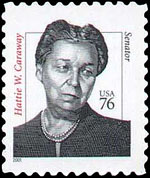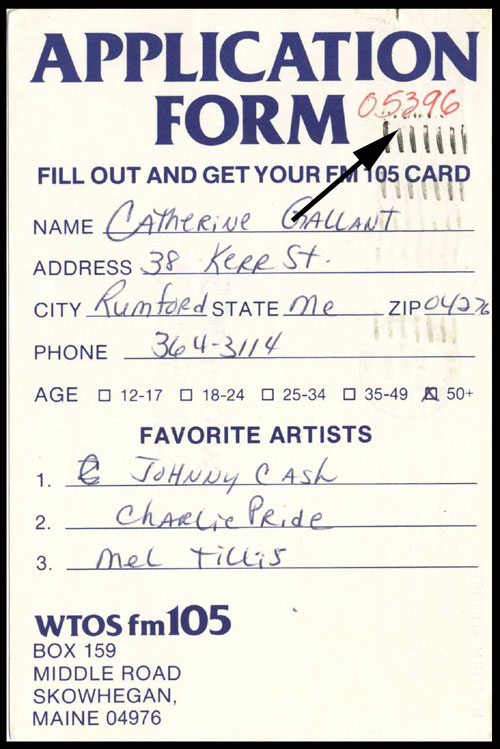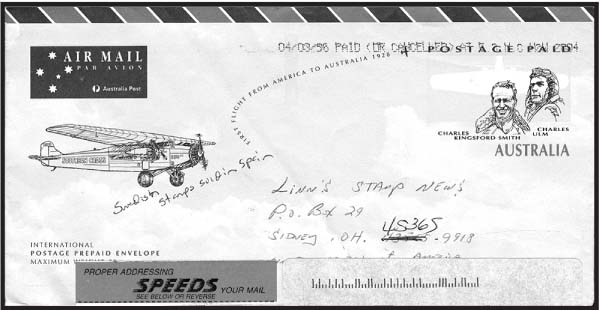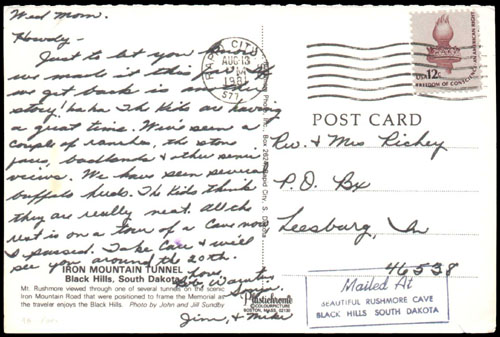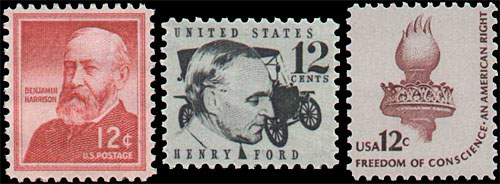POSTAL UPDATES
insights
Short rate periods sometimes yield treasures
By Rob Haeseler
For lovers of French wine, 1959 was a very good year. For collectors of United States postal history, 1981 was a good year, and 2001 may be another one.
Even in the United States, where millions of letters, postcards and government-printed postal cards are mailed every day, sometimes only limited examples survive of a certain stamp use. The 12¢ Benjamin Harrison stamp shown at the left in Figure 1 is a prime example that will be explored in this column.Like 1981, 2001 will be remembered for having a short postal rate period. Whenever rate periods of brief duration occur, which is not often, odd things can happen, and sometimes they are not discovered for a long time.
The stamp experienced extremely limited use in 1981 — something that could happen again in 2001 for stamps used to pay selected postal rates. In 1981, a rate period lasted just more than seven months, from March 22 to Oct. 31. In 2001, a rate period lasted just less than six months, from Jan. 7 to July 1.
The short rate periods in 1981 and 2001 have something else in common. They represent the only time since the inauguration of the modern U.S. Postal Service in 1971 that a recommendation of the Postal Rate Commission was overturned by the Postal Service board of governors. Both panels are appointed by the president.
Under the postal reforms of 1971, the PRC recommends new rates to the governors, who usually accept them. However, in 1981 and again in 2001, the governors didn't like the rates recommended by the commissioners and after several months tossed them out, which they may do if they act unanimously.
Many collectors will remember that the decade before the 1981 rate change was a period of runaway inflation and high interest rates. In the 1970s, the cost of mailing a first-class letter in the United States went from 6¢ (set in 1968) to 8¢ (1971) to 10¢ (1974) to 13¢ (1975) to 15¢ (1978). Simultaneously, the postcard rate went from 5¢ to 6¢ to 8¢, down to 7¢ for 14 weeks in 1975, up to 9¢ and finally reached 10¢ in 1978.
Faced with mounting operating costs, in the spring of 1981 the Postal Service board of governors wanted to increase the first-class letter rate to 20¢ and the postcard rate to 13¢. But the rate commission thought the proposal excessive and instead advised that the rates be 18¢ and 12¢, respectively. It took the postal governors several months to cut through the red tape and impose the rates they wanted. That finally happened on Nov. 1, 1981.
In the interim, new stamps had to be issued for the 18¢ first-class letter rate and the 12¢ postcard rate. So unprepared was the Postal Service for the new rate structure that it did not have a current 12¢ definitive, or regular-issue, postage stamp available for postcards, and it had to scramble to get enough 18¢ stamps printed to supplement the nondenominated alphabet "B" stamps.
At the time, the need for regular postage stamps was filled by the Americana series, which debuted in 1975. Shown at the right in Figure 1 and affixed to the postcard shown in Figure 2 are examples of the 12¢ Statue of Liberty Torch stamp in that series. This stamp was issued April 8, 1981, 17 days after it was first needed, but it took some more time for the stamp to reach post offices.
While window clerks waited for new stamps to arrive, they dug into their stocks and found an older 12¢ stamp issued by the Postal Service. It was the Henry Ford definitive shown in the middle of Figure 1 and affixed to the postcard shown in Figure 3. The 12¢ Ford stamp was issued in 1968 as part of the Prominent Americans series.
During a rate change, it is not unusual for some older stamps to get a new lease on life until they are used up or new issues replace them.
The Ford stamp was used for just that purpose until the 12¢ Torch stamp reached post offices. The 12¢ Ford on the Figure 3 postcard was mailed Aug. 11, 1981, from Yokota Air Base in Japan. Members of the U.S. armed forces who serve abroad pay domestic rates.
Figure 2 shows one of the 12¢ Torch stamps used on a vacationer's postcard mailed five days later, on Aug. 13, 1981, from Rapid City, S.D., to Leesburg, Ind.
Of the Torch and Ford stamps, it is harder to find the Ford on a postcard, but neither use is particularly difficult to acquire. They turn up regularly in modern batches of postcards at flea markets.
But the most desirable of all the 12¢ stamps used on mail during the 1981 short rate period is shown on the postcard illustrated in Figures 4 and 5. It is extremely rare.
The card belongs to Rob Washburn, who collects modern postal history. Washburn discovered that the 12¢ Benjamin Harrison stamp of 1959 from the Liberty series had been pressed into service in Rumford, Maine, in the days immediately following the 1981 rate change. Several examples are recorded, and they add greatly to the collecting excitement of that period.
Found were phosphorescent-tagged versions of the 12¢ Harrison that first appeared sometime in 1968 for use with high-speed canceling equipment.
While the tagged 12¢ Benjamin Harrison stamp was a contemporary of the 12¢ Henry Ford stamp, it lagged two definitive series behind the 12¢ Torch stamp of the Americana series. For that reason, the 12¢ Harrison was quite an old stamp to find in post office stocks in the spring of 1981.
What makes its use in 1981 so special is that no collector of Liberty series covers ever suspected that a post office would resurrect the 12¢ Harrison for use as a solo — or single — stamp to pay the brief 1981 12¢ postcard rate. But the precedent for the later use of a Liberty series stamp is well established.
Other stamps from that series surfaced out of period, notably the 25¢ Paul Revere coil, released in 1965 and issued again in 1980 in a tagged, dull-gum version. Some Revere coils can be found paying the 25¢ first-class letter rate that prevailed from 1988 to 1991 — four decades after the first Revere coil was issued.
The 12¢ Harrison of the Liberty series had been issued in June 1959 to pay the third-ounce first-class letter rate of 4¢ per ounce (Aug. 1, 1958). By the time the tagged version appeared in 1968, the first-class rate had jumped to 6¢, so the 12¢ Harrison stamp got a new lease on life paying the second-ounce rate. But by 1981, escalation of the first-class rate through the turbulent 1970s had rendered the 12¢ Harrison useless except as a change maker.
That is, until the 12¢ postcard rate period arrived, however briefly it lasted.
Washburn's 12¢ Harrison was used March 25, 1981, three days after the new postcard rate went into effect, on a contest entry to radio station WTOS-FM in Skowhegan, Maine, from a contestant in Rumford, Maine. Washburn told Linn's that he acquired up to 3,000 pieces of mail from the contest.
"Three or possibly four [were] 12¢ Harrison postcard uses. [It is the only] one left in my collection."
Contest entries came in from many communities.
"The radio station reaches most of Maine," Washburn said. "I don't recall what the exact dates of the contest were, but I believe it went for several months during 1981. There were many different weekly prizes — concert tickets ... records, restaurant meals, etc. My best guess is that all of the 12¢ Harrisons came from the Rumford post office from old stock on hand."
That's the story of the 12¢ Harrison renaissance. What mail will come out of the short 2001 rate period that will be a real prize? The best bet is the 76¢ Hattie Caraway stamp in Figure 6. It was issued Feb. 21 to pay the three-ounce, first-class rate in effect only from Jan. 7 to July 1, 2001. Watch for its proper use during that period on envelopes and packages. Most will be large items and very awkward to display, but gem items may be out there.
MORE RELATED ARTICLES
Headlines
-
US Stamps
Oct 7, 2024, 3 PMMcMurtrie dismissed as APS education director following Sept. 21 arrest
-
US Stamps
Oct 7, 2024, 12 PMVasiliauskas named president of Mystic Stamp Co.
-
US Stamps
Oct 6, 2024, 5 PMApgar souvenir card available
-
US Stamps
Oct 6, 2024, 4 PMFirst Continental Congress and U.N. stamps receive Scott catalog numbers
